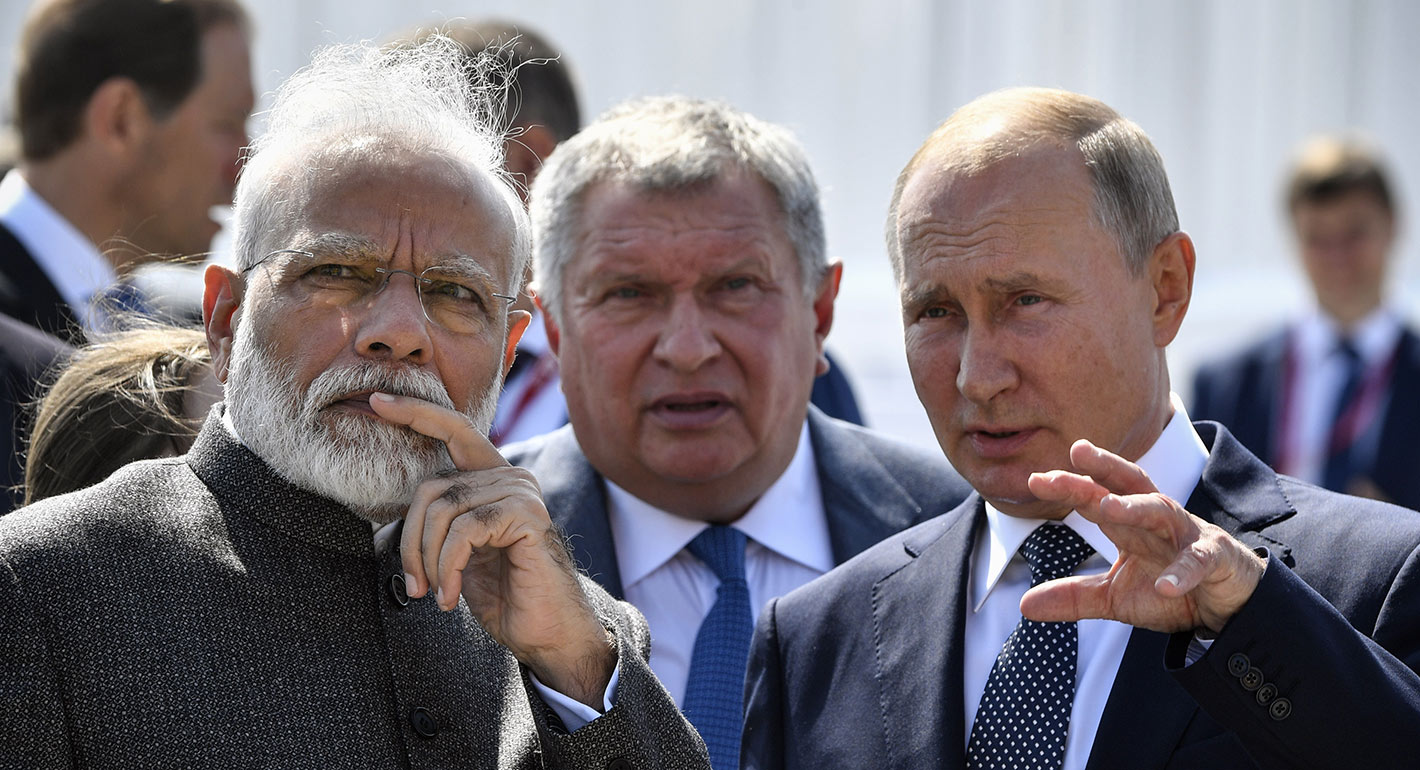In early September 2019, Indian Prime Minister Narendra Modi and Russian President Vladimir Putin met in the Russian port of Vladivostok, signing a slew of agreements and memoranda of understanding. The fifteen documents have not been publicly released, but they reportedly involve energy, defense, and bilateral trade. Signed at the twentieth annual summit between the countries, these documents aim to reinforce the countries’ historically close relationship.
Given Washington’s ties with New Delhi and frosty relations with Moscow, how worried should the United States be to see India, a key U.S. partner in Asia, buying arms from Russia? The short answer is—not very. The biggest roadblocks to a closer American-Indian partnership are largely of the pair’s own making.
India Is Keeping Its Diplomatic Options Open
The new agreements build on India and Russia’s preexisting relationship. New Delhi and Moscow mostly work together in three sectors: energy, arms sales, and trade.
On the energy front, India will continue to import Russian natural gas for a couple of reasons. First, New Delhi is the third largest energy importer in the world and needs more energy. The more energy partners India has, the more easily it can react to the changing geopolitical environment. Here is one example that highlights why: in June 2019, India was not certain whether the U.S. would grant it a waiver to continue to import Iranian oil, causing oil prices to increase. Second, India wants to manage its trade balance with Russia. Petroleum exports accounted for roughly 51 percent of Russia’s total exports in 2017.
Meanwhile, arms sales have long been a major feature of India’s relationship with Russia. Since 2001, India has tried to expand its roster of major import partners, and Russia’s share of the country’s arms imports has consequently decreased. The most recent Russia-to-India arms sale that the U.S. has an issue with is the sale of the S-400 missile defense system.

Notably, the United States is still not a major arms exporter to India. New Delhi would like to buy more weapons from Washington. But U.S. arms are expensive, and so far Russia has been more willing to sell India advanced weapons. What’s more, given India’s already large Moscow-supplied arsenal, Russian equipment is often more compatible with what India already has.
India and Russia first proposed increasing bilateral trade to $30 billion annually by 2025 back in 2014 after Modi took office. But there has been a lack of tangible progress. As IMF Direction of Trade Statistics indicates, trade volume between India and Russia continues to be very low, consistently amounting to less than 2 percent of India’s annual global trade since 2000. In contrast, India’s trade with the United States over the same period ranged between roughly 8 percent and 12 percent of India’s overall trade, reaching roughly $84 billion in 2018.

Even if India-Russia trade were to balloon, it would not put Russia in even close to the same ballpark as Washington. That said, the trade volume between India and Russia, while small, does occur in strategically critical parts of the Indian economy: energy and defense spending.
The agreements signed at the India-Russia summit do not reflect a change in India’s diplomatic posture. Instead, they show India’s desire to keep its options open, rather than embrace a traditional alliance with the United States.
Still, India’s gain—even at the hands of Russia—in some ways benefits the United States. Washington doesn’t need New Delhi to be dependent on it. It just needs India to be willing to help limit China’s ambitions in Asia. Even a small increase in trade between India and Russia would help boost India’s growth, at least at the margins. And India’s recent agreements with Russia will probably help the Modi regime to increasingly indigenize India’s weapons production through technology transfer and collaborative projects. This would support India’s “Make in India” program, launched in 2014 by Modi. Improved defense production will put India in a better position to pose a regional challenge to China’s uncontested rise in the Indian Ocean.
The Perils of U.S. Diplomatic Own Goals
Even if India’s agreements with Russia aren’t a major threat, that doesn’t mean all is well between Washington and New Delhi. There are worrying strains in the U.S.-India relationship. Beginning this year, U.S. President Donald Trump has tried to coerce India into importing more U.S. goods by ending India’s special trade privileges. This is another instance of the Trump administration weaponizing tariffs to further an economic agenda. As such, it is a greater threat to Indian-U.S. trade than Indian-Russian trade, especially as the Modi government increased tariffs against U.S. goods in response.
A second bone of contention, tied to U.S. national security concerns, is the threat of the United States imposing sanctions on India if India continues to import oil from Iran, and penalizing India for purchasing S-400 missile systems from Russia last year, through the U.S. Countering America’s Adversaries Through Sanctions Act. Among other things, this act allows the Trump administration to enact sanctions against countries that do business with the Russian defense sector. The S-400 missile system penalties will slow, potentially to a full stop, major U.S. arms sales to India such as the F-35.
So, while the United States shouldn’t worry too much about the agreements India signed with Russia, Washington should not complacently assume that relations between India and the United States will deepen of their own accord. Instead, the United States should work to resolve the tariff dispute and continue to push for greater defense cooperation and military-to-military sales to India.
Megan Maxwell is a James C. Gaither junior fellow with Carnegie’s Tata Chair for Strategic Affairs and South Asia Program.





